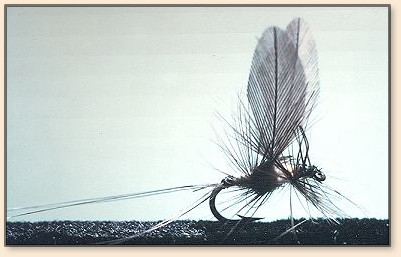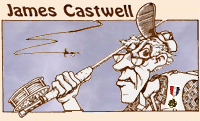|
Page 118 of What the Trout Said by
Datus Proper states, "Hackle points should not
be clipped; when blunt and stiff they penetrate
the surface more easily."
So what. For years fly houses have been selling
as 'thorax' tied flies, regular ones with the
hackle clipped from the bottom, that's what. And
it's wrong. It is not 'thorax tied' and it does
not do what they claim nor look like from below
what they say it does. It is wrong, the fly is
wrong, and they are wrong.
A hackled dry fly, mayfly type, is supposed to
represent an insect sitting high on the surface.
When the hackle is clipped, the tied fly rests
on the surface, not up, high and dry. It may
represent several things and may catch fish, but
it does not represent a fresh insect. Perhaps an
emerger, maybe a dun that is tired or struggling
to get off the surface, but not a nice newly
emerged mayfly.
From below fish can see a pattern of dimples on
the surface formed by the feet of the insect, they
often key in on these dimples, hackle can represent
these dimples. Clipping the hackle drops the tied
fly to allow the body to rest on the water, even
penetrating into the surface sometimes. Definitely
not a 'dry fly.' Some flies when new and fresh may
for a short time sit on the surface, supported by
the few hackle points which do not point straight
down, but splay out to the sides. Here quality will
help support the fly but the points penetrating the
water soon contribute to the fly wetting and dropping
down to the surface.

The only successful method of tying a fly without
any hackle not pointing down is the true V. Marinaro
thorax style. The criss-crossing of the hackle keeps
all the points at an angle and supports the fly well
above the surface. Again, quality hackle is required,
but in today's market it is readily available.
This is not to say your flies will not catch fish,
they have been and will continue. I am only saying
the clipped ones are not doing what you think they
are and not what the tiers are saying they will do.
The fact is, most tiers are not willing to learn
how to tie them and have fallen for the lie that
it is not necessary, just hack some off the bottom.
Too bad. They are not that hard to tie. In the early
seventies we taught the girls who tied for Dan Bailey's
(yes, they had a bank of ladies tying for them in
the store). It made it nice for us as we were guiding
out of there and could offer the flies to our clients.
If you decide to try these yourself, go ahead.
You will find the trout will take them very
gently as they do look like the natural. Since
the take is more gentle, you can use at least
one size lighter leader, which will also help
in the presentation of the fly. The combination
produces more hits, more runs and fewer errors.
No, I do not know of any offering them for sale.
Lastly, this is not to say all mayflies hatch
perfectly, many or even most don't. Floppy wing,
bent, broken or missing parts all combine to make
for many crippled and struggling insects on the
water. If Mr. Trout has a few of the 'perfect'
ones take flight just as he is about to lunch
on them, how long will it be before he decides
he likes the 'not so good looking ones?' The ones
that do not jump away. So, in the end...
Does it matter? ~ JC
|





